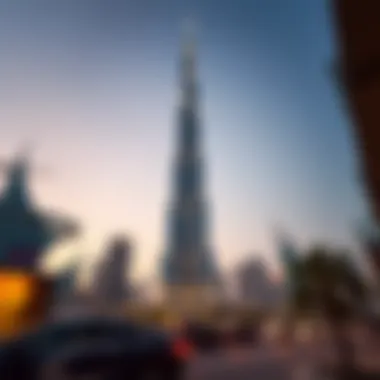HSBC Tower: A Key Architectural and Economic Icon in Dubai


Intro
The HSBC Tower holds its ground as one of the outstanding edifices that grace the Dubai skyline. An emblem of modern architectural prowess, this tower is much more than a mere structure of glass and steel. It embodies the aspirations of a city that prides itself on innovation and progress. The evolution of Dubai's real estate landscape, distinguished by its dynamic growth, intertwines deeply with the existence of this landmark.
In this article, we will take a closer look at the historical background of the HSBC Tower, explore its design features that contribute to its status as an architectural feat, and assess its economic implications on both a local and an international scale. Moreover, we'll delve into the sustainable practices adopted in its construction, which could serve as a beacon for future developments in the region.
As we analyze market trends and property developments surrounding the HSBC Tower, the potential investment opportunities arise from its location and significance. The future prospects of this tower promise a blend of rich heritage and vibrant economic activity, making it a pivotal point of interest for investors, real estate professionals, and stakeholders in the urban fabric of Dubai.
Foreword to HSBC Tower
The HSBC Tower stands tall as a hallmark of Dubai’s architectural prowess and economic vitality. Its significance stretches beyond the mere physicality of the structure. It symbolizes the ambitions of a rapidly developing city that constantly endeavors to position itself on the global stage. This article dissects the layers that contribute to the Tower’s prominence, from its architectural brilliance to its influence on the local economy, presenting a holistic view of its impact on Dubai’s urban landscape.
Overview of the Structure
The HSBC Tower is not just another addition to Dubai's skyline; it is a marvel that showcases cutting-edge engineering and design principles.
With 47 floors rising into the sky, the tower is primarily constructed using reinforced concrete wrapped in a glass facade that reflects the city's light. The structure boasts a distinct slanted roof, which is reminiscent of traditional Islamic architecture, presenting a subtle nod to the city’s rich cultural heritage. Its exterior is designed to withstand the harsh climatic conditions of the region, hence employing advanced insulation materials that reduce heat gain, thus contributing to energy efficiency. This careful balance of aesthetics and functionality creates a building that is not only captivating to look at but also operationally sustainable.
The design also allows for ample natural light to fill the office spaces, which is essential in fostering a productive work environment. Moreover, the base of the tower features landscaped gardens, creating green spaces amidst the bustling urban life, which enhances the overall atmosphere of the area.
Location and Context
Nestled in the heart of Dubai’s financial district, the HSBC Tower occupies a prime piece of real estate that connects various parts of the city with ease. Located on Al Maryah Island, it is surrounded by a hub of activity, including luxury hotels, shopping centers, and other corporate offices. The tower's strategic positioning underscores its role as a nexus for both local and international businesses.
The surrounding context not only amplifies the tower's visibility but also serves as a catalyst for economic activity. By being in proximity to various amenities, the HSBC Tower attracts professionals and businesses alike, contributing to the vibrancy of the financial district. Moreover, with Dubai’s ongoing development initiatives aiming to boost international tourism and commerce, the tower is poised to remain a key player in the city’s ambitious vision for the future.
This prime location, combined with its architectural flair, enhances the tower's significance as both an economic and symbolic landmark in Dubai.
Historical Background
Understanding the historical backdrop of HSBC Tower is essential to grasp the multifaceted impact it has had on Dubai's urban landscape and its economy. Recognizing how this tower evolved through various phases of planning and development reveals not only the aspirations tied to its construction but also sheds light on the broader economic climate of Dubai at the time. The HSBC Tower, completed in 2010, symbolized a significant investment that mirrored Dubai's ambition to position itself as a global banking and financial hub.
Timeline of Development
The development timeline for the HSBC Tower showcases the meticulous planning and execution that went into this architectural feat. Here’s a brief overview:
- 2004: The conceptual design for the tower was initiated amid Dubai’s rapid economic growth and diversifying economy.
- 2005: Construction commenced, with the project taken on by renowned architects and engineers who aimed to create a state-of-the-art commercial space.
- 2007: Major structural work was completed, allowing the building to rise prominently against the skyline.
- 2010: The facility was officially opened, marking it as a major milestone in Dubai’s architectural timeline.
The timeline reflects a period where Dubai was redefining its place on the global stage. The skyscraper not only provided a new home for HSBC but also acted as a beacon for other international investors looking to enter the regional market.
Architectural Inspirations
The design of HSBC Tower was deeply influenced by both modern architectural trends and elements reminiscent of traditional Islamic art. The architects drew inspiration from various sources, marrying contemporary aesthetics with cultural depth. Notable features include:
- Geometric Patterns: The façade incorporates intricate geometric designs that pay homage to traditional Islamic architecture, demonstrating how old and new can coexist in harmony.
- Sustainable Features: Inspired by the need for environmental consideration, the architects integrated sustainable design principles that became foundational for future projects in the city.
- Verticality: The tower reaches a height of 180 meters, emphasizing Dubai's essence as a city that aims high, both literally and metaphorically.


This blend of inspirations is not just about looks. It reflects the city's growth ambitions, catering to a modern audience while maintaining respect for cultural identities.
"HSBC Tower aligns with the vision of Dubai as a city that embraces innovation while honoring its unique heritage."
In summary, the historical background of the HSBC Tower encapsulates a critical juncture for Dubai, where architectural innovation meets economic foresight. This section underlines how the tower served not only functional purposes but also represented a culture that cherishes progressive ideals while being anchored in tradition.
Design and Architecture
The design and architecture of HSBC Tower are not just about aesthetic appeal; they represent a pivotal shift in Dubai's approach to urban planning and sustainable construction. This towering structure is a profound statement of intent, demonstrating the city’s ambition to blend economic functionality with architectural ingenuity. Amidst a skyline filled with competing designs, HSBC Tower stands out—not just for its height but for the thoughtful elements that have gone into its creation.
Architectural Features
HSBC Tower incorporates a myriad of architectural features that exemplify modern design while respecting the cultural heritage of Dubai. The facade is adorned with glazing that creates a contemporary look while also allowing for natural light to flood the interiors. This design choice not only enhances the aesthetic but also promotes energy efficiency, reducing the need for artificial lighting.
The building is characterized by its unique shape, which resembles a sail. This design is more than just visually pleasing; it serves a practical purpose by reducing wind load on the structure, an essential consideration in Dubai’s breezy environment. The facade also incorporates adaptive shading devices that minimize heat gain during the intense summer months, which can be a boon for energy conservation.
Some noteworthy architectural features include:
- Vertical gardens that enhance the environmental aspect and improve air quality
- Open floor plans that promote collaboration and flexibility for tenants
- A green roof that provides insulation and helps manage rainwater runoff
Through these architectural innovations, HSBC Tower communicates a vision that marries functionality and environmental responsibility.
Sustainable Design Practices
At the heart of HSBC Tower's architecture lies a commitment to sustainable design practices, which resonate deeply in Dubai's evolving landscape. The tower has gained recognition not only for its grandeur but as an exemplar of green building methods.
The use of recycled materials in construction, along with technologies that support energy efficiency, such as advanced HVAC systems and energy-compliant glass, showcases the project�’s alignment with sustainable development goals. Consider the implementation of solar panels on selected areas of the roof—these are generating a portion of the building's energy needs, reducing its carbon footprint.
Moreover, HSBC Tower adheres to the principles outlined by Leadership in Energy and Environmental Design (LEED), an internationally recognized green building certification. The adoption of water-efficient fixtures is another measure that helps in conservation, reflecting a mindful approach towards resource management.
In summary, the design and architecture of HSBC Tower are much more than about looks; they underscore a philosophy that urges the construction industry to incorporate sustainability into their DNA. This approach not only ensures that current generation needs are met but also preserves resources for future development, standing as a testament to Dubai’s vision of innovation in architecture.
"In architectural realms, sustainability is no longer a choice but an imperative."
This paradigm shift towards sustainable practices and innovative design spells potential benefits for investors and developers engaging with Dubai's realty scene. The HSBC Tower embodies these principles, serving as both a strategic business venue and a landmark of architectural integrity.
Economic Significance
The relevance of the HSBC Tower extends far beyond its impressive façade. It serves as a pivotal component of Dubai’s economic framework, influencing both well-established sectors and emerging markets. The significance of this landmark lies not only in its architectural beauty but in its ability to stimulate growth, attract investment, and create job opportunities. As the city navigates its path towards becoming a global business hub, the tower plays a crucial role in shaping that reality.
Impact on Local Economy
The HSBC Tower has had a profound impact on the local economy of Dubai. One of the foremost benefits is the influx of jobs that has resulted from its establishment. The presence of such a prominent institution in the region has provoked a chain reaction, attracting both ancillary services and other corporate entities to the area.


- Increased Employment Opportunities: Local firms benefit from the demand for various services, ranging from catering to IT support, all feeding off the increased activity brought by HSBC. As this demand grows, so does the employment in allied sectors, impacting thousands of local residents.
- Boosting Retail and Hospitality Sectors: The tower’s vicinity has seen a rise in cafes, restaurants, and shops, tailored to an international clientele. This growth in retail contributes to the vibrancy of the local economy.
- Connectivity and Infrastructure Improvements: With a substantial corporate presence, local infrastructure – in terms of transportation and utilities – sees enhancements. Projects aimed at improving the surrounding infrastructure not only support the tower's operations but elevate the overall standard of living for residents.
It’s no surprise that the tower has catalyzed economic activity in its vicinity. This ripple effect ultimately strengthens the local economy, enhances the quality of life, and boosts the city’s appeal for further investments.
Attracting International Business
In today’s globalized environment, international businesses are increasingly selective about their locations, and the HSBC Tower positions Dubai as a compelling contender on that front. Its appealing design and prime location make it a sought-after base.
- A Magnet for Multinational Corporations: The tower’s stature and HSBC’s reputation offer an attractive premise for companies looking to set up operations in the Middle East. This lure not only brings more multinational players to Dubai but also elevates the city's status as a regional business haven.
- Facilitating Global Connectivity: With Dubai serving as a central hub for international travel and trade, the HSBC Tower’s strategic position allows businesses to tap into global markets efficiently. The accessibility for clients and partners becomes a viable selling point for companies considering the shift.
- Fostering Business Networks: The concentration of various industries in and around the HSBC Tower fosters an essential network of businesses, promoting partnerships and collaborations that may lead to innovation and economic development.
Dubai’s importance in the global business landscape is enhanced by the presence of landmark structures like HSBC Tower, demonstrating how architecture and commerce go hand in hand in driving economic growth.
In summary, the HSBC Tower's economic significance is multi-faceted, ranging from local employment generation to attracting global businesses. The tower stands not merely as a building but as a cornerstone in Dubai’s continuous journey toward becoming a preeminent center for international commerce.
Real Estate Dynamics
The discussion of real estate dynamics is crucial when we look at the impact of the HSBC Tower on Dubai's landscape. As this towering piece of architecture stretches high into the sky, it's not just a physical presence; it also shifts various market dynamics. The importance lies in how such a structure influences both commercial opportunities and the broader market environment.
Market Trends Influenced by HSBC Tower
The HSBC Tower inevitably influences real estate trends in Dubai. With its listing as one of the most prominent structures in the city, it brings a wave of new interests to the area. Here are a few notable aspects of how market trends are shaped:
- Increased Demand for Commercial Spaces: Since its completion, an increase in companies looking to establish their presence nearby has become evident. Businesses, especially in finance and technology, seek proximity to such a significant entity, essentially leading to more demand for office space in the vicinity.
- Rise in Real Estate Development: The area surrounding the HSBC Tower has seen a flurry of developmental activity. New projects are popping up, ranging from luxury apartments to retail hubs, transforming the skyline even further.
- Shift in Buyer Preferences: Investors and buyers are now more inclined to see nearby developments as part of a larger picture. A property’s worth does not just derive from its individual value but also from its context within the market.
- Capitalizing on Connectivity: The strategic placement of the HSBC Tower has improved accessibility across the region. As many people flock to the area, there is a palpable increase in foot traffic that benefits the local businesses and subsequently the real estate market.
In essence, the influence of the HSBC Tower extends beyond its monumental height; it encompasses a variety of market dynamics that ripple through the local ecosystem, marking it as a catalyst in Dubai's booming real estate sector.
Impact on Property Values in the Area
The implications for property values tied to the HSBC Tower's presence cannot be overlooked. As businesses flourish and new developments arise, here are some key factors that affect property valuations:
- Value Appreciation: Properties in close proximity to the HSBC Tower have seen notable appreciation in value. The prestige associated with such an iconic structure elevates the desirability of the area, resulting in rising prices.
- Commercial Rate Adjustments: The essence of being near a reputable landmark means that landlords can command higher rents. This increment in commercial real estate pricing is a direct reflection of the perceived configuration of being associated with a highly recognized financial institution.
- Long-term Investments: The anticipation of future developments has made the region attractive for long-term investments. Investors are often keen to capitalize on the increasing demand for both residential and commercial spaces, which can yield favorable returns.
- Gentrification Trends: As the area develops with high-end projects, it often spurs gentrification. This phenomenon could lead to the displacement of lower-income residents in the surrounding neighborhoods, shifting the socio-economic landscape, and further influencing property values.
Cultural Impact
Cultural impact of the HSBC Tower goes beyond its striking appearance. It not only marks the skyline but also lays claim to a significant role in the cultural narrative of Dubai. The interaction between architecture and community development is vital to understanding how such landmarks shape urban identity.
As a Symbol of Modernity
When we talk about the HSBC Tower, it stands tall as a beacon of modern architecture in Dubai. Its sleek design reflects a shift towards contemporary aesthetics that have come to symbolize the rapid advancement of the city. The glass façade that glimmers under the Dubai sun is not just about looks; it’s indicative of a broader trend in embracing innovation. This building encapsulates the spirit of a city striving to be at the forefront of global finance while embracing modern architectural philosophies.
In its design, HSBC Tower employs advanced engineering techniques and sustainable practices, thus setting a precedent for future buildings. This is crucial in a region where tradition often intertwines with the notion of progress. The structure gives visitors and residents alike a tangible connection to the city’s aspirations.


The tower’s height and design also resonate with the local community. It isn’t just another skyscraper; rather, it stands as a testament to what Dubai represents: ambition and the pursuit of excellence. Its presence is a constant reminder that the future is now, encouraging a mindset fostered around innovation and growth.
Role in Community Development
The HSBC Tower plays a multifaceted role in fostering community development within Dubai. Firstly, the surrounding area has benefited economically from the influx of businesses and professionals. It’s not just about financial transactions; it's about creating a vibrant community where people work, socialize, and thrive together. The jobs created due to the tower have stimulated growth in local businesses, ranging from cafes and restaurants to retail shops that cater to a diverse crowd.
Moreover, the HSBC Tower encourages community engagement by hosting various events and activities. These initiatives create a lively atmosphere, drawing residents and visitors, bridging the gap between different cultural backgrounds. This melding of identities and experiences is essential for a city that prides itself on diversity.
Lastly, the tower symbolizes Dubai’s commitment to sustainability and responsible development. The architectural designs promote a green consciousness that is intertwined with community values, engaging locals in dialogues around ecological awareness.
"The HSBC Tower is more than just a building; it is a catalyst for community spirit and sustainable growth, reflecting the aspirations of a nation."
As Dubai continues to evolve, the cultural implications of such structures will only grow, enhancing the complex tapestry that defines this remarkable city.
Future Outlook
The future of HSBC Tower not only encompasses its structural integrity and aesthetic allure but also its potential to ignite further economic development in Dubai. This outlook serves as a lens through which stakeholders can gauge the long-term impacts of the tower on the surrounding environment, real estate trends, and local businesses. As the city forges onward, the tower stands as a benchmark, embodying sustainable architecture and modern business practices—qualities crucial for cities aiming for growth while preserving their unique culture.
Expected Developments in the Area
The dynamic landscape surrounding HSBC Tower holds numerous developments on the horizon. Key projects include enhancements to public transportation and infrastructure, aiming to optimize connectivity for both residents and visitors alike.
- Expansion of the Metro System: Anticipated improvements in the Dubai Metro lines will enhance accessibility, potentially increasing foot traffic to nearby commercial ventures.
- Green Spaces Initiatives: Plans are underway to introduce parklands and recreational areas, promoting a balanced lifestyle and attracting families to the area.
- New Commercial Developments: Additional office spaces and retail options are expected to pop up, catering to both local and international businesses that seek to capitalize on the helicopter view of the bustling metropolis.
These developments, mingling with the HSBC Tower's significance, can dramatically uplift the local economy and enhance the overall quality of life for residents.
HSBC Tower’s Role in Dubai's Vision
HSBC Tower sits at the heart of Dubai's ambitious vision for the future. It aligns seamlessly with the city’s goal of becoming a leading global business hub epitomized by innovation and sustainability. The tower isn’t simply a structure; it's a symbol of how modern architecture can weave with economic strategy.
- Catalyst for Foreign Investment: With its position in the business district, the HSBC Tower attracts investors, offering a beacon of growth and opportunity. International businesses often view the tower as a reliable starting point for operations in the region.
- Sustainability Leadership: As the region pivots toward eco-friendly practices, the tower’s green credentials offer a template for other developments, fostering a culture of responsibility in construction and urban planning.
- Integration with Smart City Initiatives: HSBC Tower enhances Dubai's trajectory towards becoming a smart city, equipped with advanced technologies that improve energy efficiency and connectivity.
"The present is what you live, but the future is what you create." This perfectly encapsulates HSBC Tower's purpose in shaping not only its immediate vicinity but also the broader urban landscape.
The End
The conclusion serves as the capstone of the discussion surrounding the HSBC Tower and is pivotal for underscoring the overall significance of the structure as a hallmark not only of architectural prowess but also of economic dynamism in Dubai. It pulls together fragmented insights, reinforcing the idea that this tower represents more than mere concrete and glass; it embodies a thriving business ecosystem and a step toward sustainable urban living.
Summary of Key Points
In reflecting on the key elements that have shaped the perception and reality of the HSBC Tower, the following points emerge:
- Architectural Influence: The design remarkably blends modern aesthetics with functional requirements, setting a standard for future builds in the region.
- Economic Impact: It has stimulated local job markets and fueled investment, becoming a pivotal player in attracting international businesses.
- Cultural Significance: As a symbol of Dubai's ambition, it encapsulates the city's rapid evolution and its determination for cultural progress.
- Sustainability Practices: Incorporating green techniques, the tower is a benchmark for developments that aspire to balance growth with ecological responsibility.
- Legacy and Future Outlook: The HSBC Tower stands as a testament to effective urban design strategies within Dubai's grand vision for development and modernization.
Final Thoughts on HSBC Tower
In closing, the HSBC Tower is a multifaceted structure that resonates deeply within the realms of architecture, economy, and culture. It not only reflects the ambitions of global financial institutions but also highlights Dubai's phenomenal rise on the world stage. For investors, real estate agents, and community developers, the tower's significance extends beyond its towering height; it is a strategic landmark that shapes market dynamics and community interactions.
Ultimately, as Dubai continues to evolve, the HSBC Tower will likely remain a cornerstone in shaping the city's future landscape, embodying the vision that melds progress with sustainability, and innovation with tradition. Its role in promoting a robust economic environment while maintaining a commitment to environmental integrity cannot be overstated, making it an essential subject for those with an interest in the city’s trajectory.















